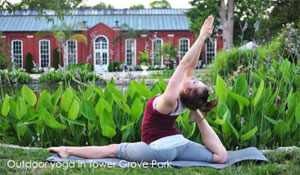Organize a Walking Group or Community Fitness Program
Collective fitness is typically easier to commit to than individual fitness programs, and it also promotes neighborhood solidarity, use of public spaces, and overall neighborhood safety.
Description

A Walking Group is a group of residents that have a regularly scheduled time to walk around the neighborhood to be healthy and social at the same time. A community fitness program is similar, but can involve more kinds of activities, including yoga, running, park fitness courses, bike rides, dance classes, and pick up sports games. Collective fitness is typically easier to commit to than individual fitness programs, and it also promotes neighborhood solidarity, use of public spaces, and overall neighborhood safety.
Related Tools
When paired with other tools, a walking group or community fitness program can contribute to a healthier, more active, and safer neighborhood. Think about community cohesion, public safety, local prosperity, and healthy, vibrant communities. Try combining this with:
Community Projects
Add your project
Neighborhood Benefits
Environmental
- Added value to parks and public spaces
- Support for alternative transportation use
- More people spending time outside and among nature
Social
- New and stronger community relationships
- Healthier lifestyles for participating residents
- Positive activation of local, public outdoor space
- Increased pedestrian safety
Economic
- Increased access to, and awareness of, local and neighborhood businesses
- Reduced health problems and lower medical costs for healthier individuals
Get Started
- Benefits For many people, finding time and resources to exercise regularly is difficult. Family and work obligations get in the way of good health, and a gym can be expensive and hard to get to. Having regular opportunities and the encouragement of others can help reduce barriers to participation. Exercising in your neighborhood or local park does not take excessive travel time or require a membership fee.
- Search There may be a fitness group in your neighborhood or park already. Check with your neighbors and neighborhood association to get more information. Meetup.com is also a popular site for organizing fitness groups, so check there for more information. Programs inclusive of youth and seniors are a good way to reach more people.
- Choose an Activity If you are just beginning, decide what kind of exercise you want to do. The most basic is to begin with a walking group for 30 minutes to one hour per session. You can meet once a week or more than that depending on what works for your schedule. Other fitness programs can also include yoga, dancing, pick-up sports games, jogging, and bike riding. Plan for the activity to happen throughout your neighborhood or in a local park. For example, dance classes could be held in a pavilion and yoga can be held in the park similar to Yoga in the Park in Tower Grove Park.
- Schedule Choose a convenient time for exercising and send out notices and invitations. You can start with friends and if you want to expand your group, contact your neighborhood association to put an ad in the newsletter, create flyers for mailboxes, or talk to parents at your neighborhood school. Provide your name and phone number or email address so people can contact you. Consider how many people you want to be in your walking group or fitness program. If you are unsure of what kind of exercise you want to do or what time, solicit input from other members.
- Encourage Create goals or challenges to keep everyone interested and progressing. A challenge is not meant to make competition within the group, but to encourage one another to keep participating. For example, you can count the number of steps you take each week, and next week, try to take more.
- Play Occupying your neighborhood streets and parks makes them safer. If neighbors see a group of friendly residents using parks and sidewalks for fitness and fun, there is less chance of unwanted behavior since community residents are around to observe. To take extra precaution however, contact the police and inform them of your schedule and route. They will be able to give you safety tips and can patrol the route while you are there.
- Track your progress Often, seeing your progress written down brings an extra sense of accomplishment. You can do this at home, keep a blog, or post it on a public bulletin board at your community center or park. Making your activities public encourages others in your neighborhood to be proactive about their health as well.
- Make it Fun Public infrastructure improvements in your parks or on your streets can make your fitness routine more of a community activity. Creative sidewalk markings or clever signs like Walk Your City can make neighborhood exercise safe, accessible, and fun for everyone.
Related Categories
Sustainability Plan Categories
Project Scale
- Block
- Neighborhood
Download This Tool
Organize a Walking Group or Community Fitness Program Doc (367.16 KB pdf)
Need Help Viewing?
You need a program that can open Adobe PDF files. A free option:
- Adobe Reader can read PDF files
Help Us Improve This Page
Did you notice an error? Is there information that you expected to find on this page, but didn't? Let us know below, and we'll work on it.
Feedback is anonymous.